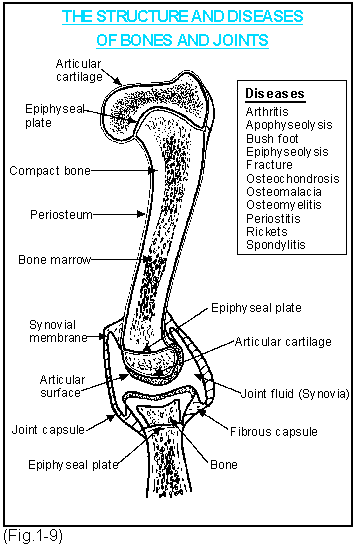



Skeletal system

The structure of a bone and joint are shown in Fig.1-9. A joint consists of the ends of two bones held together by ligaments and muscles, surrounded by a strong membrane and covered with smooth cartilage which form what are known as the articular surfaces. Cartilage is dense material that is shock absorbing. The two articular surfaces are surrounded by a thin membrane called the joint capsule, the inner part of which is secretory and produces the joint fluid (synovial fluid). The muscles and ligaments surrounding the joint are attached to the periosteum, the membrane which covers bone. Beneath the periosteum is the layer of compact bone that provides the strength of the structure. The centre is composed of a spongy mass containing marrow, from which many of the cells circulating in the blood are produced. Near the ends of the bones are flattened areas of cartilage running at right angles to the bone called the epiphyseal plates, which by increasing their thickness cause bones to grow in length and width. The separation of bones at these plates is a common occurrence in leg weakness or osteochondrosis, particularly in young growing animals.
Bone is continually being broken down and rebuilt even in adults who have stopped growing. Thus they are able to repair fractures and respond to pressures. The main pressures are from muscle tone and exercise. Pigs that are able to exercise are likely to have stronger bones and joints than those that can not. Thus sows kept in total individual confinement have softer more brittle bones than sows kept in pens, yards, or outdoors.
In contrast, the articular cartilage when damaged and eroded cannot repair itself and is replaced by less effective fibrous tissue. This process can be progressive.
Terminology
Adventitious bursa - A soft swelling containing fluid, resulting from a callous. Often found over the hock and elbow.
Apophyseolysis - Separation of the growth plate at the point of attachment of the main muscle mass on the back of the pelvis. It is commonly seen in the second parity female. The hind leg cannot be pulled backwards because the muscle attachment has been lost.
Arthritis - Inflammation of the joint. This can occur as a result of damage, but in the pig most cases are caused by infection resulting in increased synovial fluid, inflammation of the synovial membrane, sometimes erosion of the articular cartilage and sometimes the formation of pus. It is an extremely painful condition and makes the pig lame. Common infections causing this include Mycoplasma hyosynoviae, Haemophilus parasuis, streptococci, staphylococci, Coryne bacterium and Erysipelothrix rhusiopathiae.
Bush foot - Infection of the hoof and the bones in the foot. It arises from trauma and damage to the solar surface of the hoof. The claw is often swollen.
Bursa - A true bursa is a sac containing lubricating fluid but in pigs the term is often used to describe a fibrous lump beneath the skin covering bony prominences, caused by constant pressure.
Callous - An outgrowth of bone due to trauma to or irritation of the periosteum.
Chondrocytes - Cells found in cartilage. They form future bone.
Crepitus - The broken ends of bone rubbing together.
Epiphyseolysis - Separation of the epiphyseal or growth plate. It occurs as part of the leg weakness syndrome and fractures can occur for example, in the ball and socket joint of the femur. In young growing animals separation of the plates in the vertebrae in the spine can result in spinal paralysis.
Foot rot - Infection involving the soft tissues between the two claws.
Laminitis - Inflammation of the soft sensitive tissues inside the hoof.
Leg weakness - A term used to describe conformation defects and abnormalities of gait in both fore and hind limbs. It is also used to describe osteochondrosis.
Osteomyelitis - Infection of the bone itself and the bone marrow in its spongy centre. It can occur after a septicaemia with organisms such as streptococci and erysipelas. It is often seen in the jaw bone after faulty teeth clipping.
Osteomalacia - This describes a softening of the bones and is caused by poor calcium and phosphorus deposition into the compact bone. This can be associated with the loss of these minerals during lactation or their unavailability in the diet.
Osteochondrosis (OCD) - This involves changes in the articular cartilage and the bone and it is very common. Most if not all modern pigs show such changes to bone structure at a microscopic level. Another term is leg weakness.
Periostitis - Inflammation of the periosteum. This is extremely painful and can arise through trauma or occasionally infection. The most common causes are mechanical damage to knees in sucking pigs, swelling or leg calluses particularly on the hind legs, seen on many animals that are reared on concrete floors.
Rickets - Soft bones due to a shortage of phosphorus or deficiency of vitamin D.
Rig - Synonymous with cryptorchid - A boar in which one or more testicles have not descended into the scrotum.
Synovial fluid - Oily fluid in the joint.
Synovitis - Inflammation of tendon sheaths and joint capsules.
Tenosynovitis - Inflammation of tendons and tendon sheaths. Often caused by Mycoplasma hyosynoviae.





